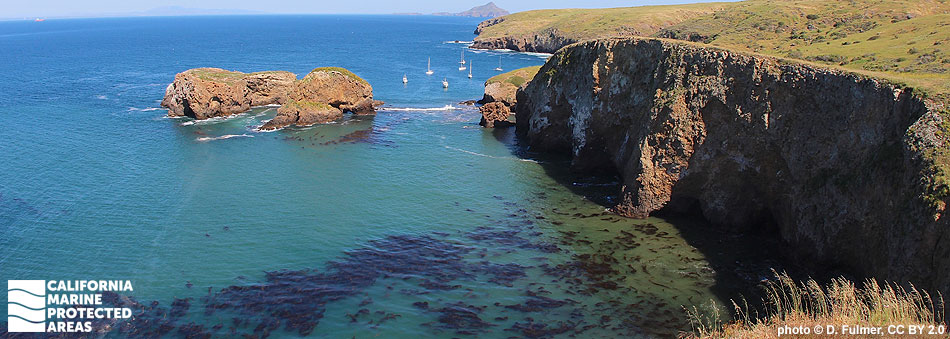
Overview
Scorpion State Marine Reserve (SMR) and the federal Scorpion Marine Reserve (FMR) are located south of mainland Santa Barbara on the northeast side of Santa Cruz Island, the largest of California’s Channel Islands. The SMR covers almost 10 square miles, includes a shoreline span of almost 3½ miles, and reaches depths greater than 760 feet. Where the SMR ends at three nautical miles from shore, the FMR continues farther offshore to meet the outer boundary of the surrounding Channel Islands National Marine Sanctuary.
This marine protected area (MPA) is fed by cold, nutrient-rich waters, which help to sustain a diverse web of marine life. Its sandy beaches and rocky shores transform to sandy and rocky seafloor beneath the surface, supporting eelgrass beds and dense kelp forests. Halfmoon, blacksmith, Pacific sardine, kelp bass and California sheephead swim through the kelp while California spiny lobster, sheep crab, and warty sea cucumber crawl along the sandy and rocky seafloor. Seasonally migrating yellowtail, barracuda, and bonito can be found in the open waters farther offshore, and marine mammals like California sea lions and harbor seals visit frequently.
Scorpion Anchorage, a small harbor, is only a one-hour boat ride from Ventura Harbor, and has one of the most accessible beaches for visiting Santa Cruz Island and the SMR. Visitors can see marine wildlife and a wide variety of birds such as black oystercatchers, peregrine falcons, pigeon guillemots, and even bald eagles.
Regulations
It is unlawful to injure, damage, take, or possess any living, geological, or cultural marine resource.
California Code of Regulations Title 14, Section 632(b)(110)(opens in new tab)
Note: The state and federal marine reserves share identical regulations.
Quick Facts
These facts are for the state marine reserve only.
MPA size: 9.64 square miles
Shoreline span: 3.4 miles
Depth range: 0 to 769 feet
Habitat composition*:
- Rock: 0.62 square miles
- Sand/mud: 7.37 square miles
*Habitat calculations are based on three-dimensional area and may exceed the total MPA area listed above.